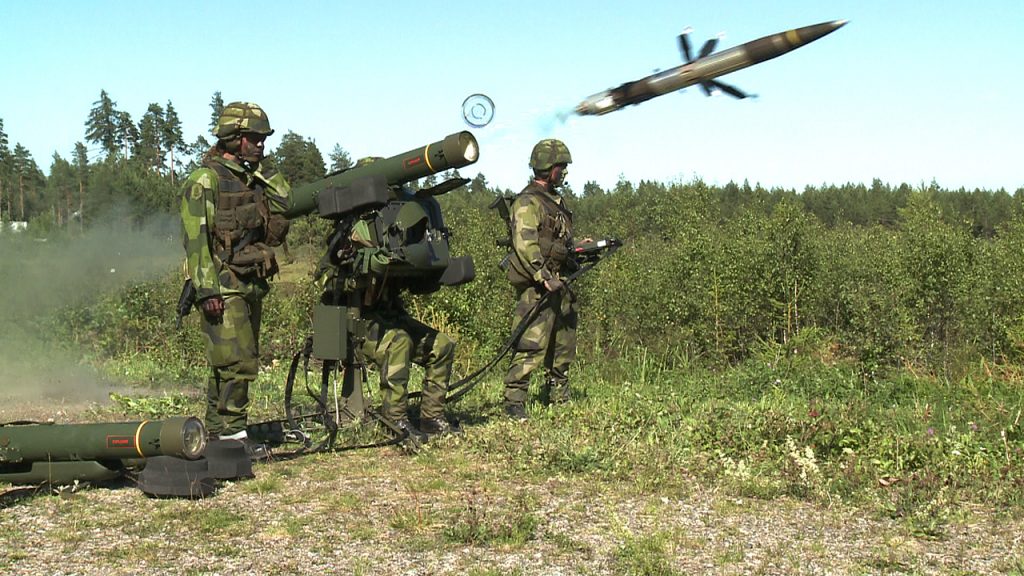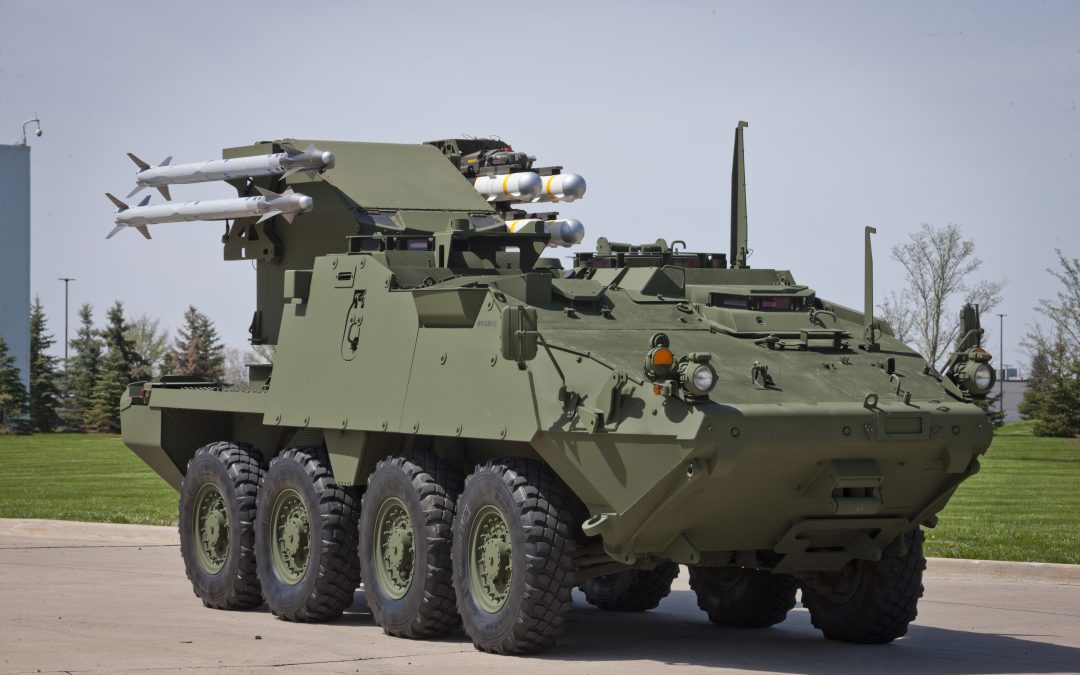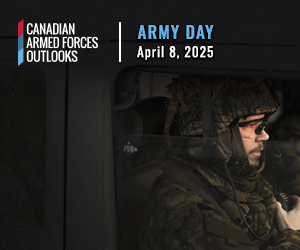By Ian Coutts
There is a classic cartoon by Bing Coughlin from the Canadian Army’s old Maple Leaf newspaper featuring Herbie, his archetypal Canadian soldier of the Second World War. In it, Herbie, cowering with his pals in a crude shelter in the midst of a fiendish bombardment, looks up and notices an astounding selection of objects hurtling overhead – a steel rail, a big pipe, a stove and, as he remarks incredulously, “Even the kitchen sink!”
There must have been times when it felt like that. And indeed, times today when it still does. A modern soldier looking up in the battlespace might see a bewildering array of objects passing overhead: Not merely fixed-wing aircraft and helicopters, but mortar shells, cruise missiles, surface-to-surface rockets and even, potentially, swarms of drones. All intent on doing him or her harm.
Hopes are the Army’s new Ground Based Air Defence (GBAD) system will help to counteract all of these threats, by sometime in the middle of the next decade. In the not-so distant past, the Army could field a selection of weapons capable of engaging low-flying aircraft, ranging from shoulder-launched Javelin missiles to a radar controlled Oerlikon-Contraves GDF 35mm twin cannon, to Aerospace Oerlikon’s combined air defence anti-tank system. The last of those air defence capabilities was retired in 2012.
Canada wasn’t alone in neglecting these systems. As Major Bruno Di Ilio, the lead on the GBAD project, pointed out, “There was a big downturn on the West’s part in terms of air defence capability because we always thought we had air superiority, so we didn’t need it.”

RBS 70 NG live firing at Bofors Test Center, Karlskoga, Sweden
However, said Di Ilio, experiences with mortars and surface-to-surface fire in Afghanistan, along with recent conflicts in Ukraine and elsewhere, have led to a reappraisal of air defence. As well, there is a growing awareness of the dangers posed by drones and other unmanned aerial vehicles (UAVs).
For all these reasons, after a gap of several years, the search for a new ground air defense system was listed in Strong, Secure Engaged, the government’s June 2017 defence policy, as one of the Army’s key priorities.
When Di Ilio, himself a gunner, discusses GBAD, he talks about it as “a system of systems.” At heart, it involves four key components: A sensor system using both radar and electro-optical or infrared components – the new medium range radar will contribute part of that; an air defence management component to identify aerial threats; and a communications system.
Fourth and finally, he said, “If there is a threat, we need an effector capability to neutralize and/or defeat the threat.” This is where GBAD gets interesting. The system may depend on “hard kill” options, the so-called “kinetic” weapons like guns or missiles, or “soft kill” weapons, of which high-energy lasers or electronic jamming might be prime examples.
In fact, the system might rely on both. That’s reflective of a major shift in targets, which previously emphasized an anti-aircraft response.
“Our primary target set is the RAM [rocket, artillery, mortar] projectiles,” said Di Ilio. “The other category that fits into the primary target set is air-to-surface munitions, essentially those delivered from helicopters or fixed-wing platforms.”
Beyond that, GBAD will also prioritize UAVs, “mainly the small unmanned systems and the Class II systems, which are up to about 500 kilograms in weight.”
Dealing with such a selection of threats is a daunting task. As Di Ilio put it, “a mortar shell is very small and very difficult to take out.” But not impossible. In August 2018, as part of the options analysis phase of the GBAD project, Di Ilio and his colleagues sent out a request for information to potential suppliers outlining the project’s goals.
“We ended up receiving over 15 packages,” he said. “Some of them were just specifically focused on missile systems, some were on gun systems. All of them, though, provided a complete package of sensors, communications, command and control and the effector platforms.”
He and his colleagues are also looking at what allies have adopted or are considering. “We’re not looking at going into development to build a system that is one-of,” he said. “Whatever the UK or the US are planning on procuring, we’re very much interested. There are savings to be had if we have commonality of fleets.”
He cautioned, though, that it is still early days. “You have to consider that we are not procuring this for at least another five years. What we’re doing right now is evaluating the different systems. Some of them are operational and some are systems that are in development.”
Di Ilio said that whatever the Army acquires, it must be capable of providing air defence for a brigade, whether it is involved in peacekeeping or in a conflict zone, which means the area to be protected could vary greatly in size. The Army will also need enough systems to provide cover for two separate deployments at the same time.
The precise structure of the units operating the system hasn’t been determined but, he said added, “We’re going to have a structure based on troops and batteries similar to the organization that we have in the artillery now.”
The Army pegs the cost at between $250 million and $499 million, but that is very much an estimate. The goal is for an initial operating capability by 2025. After which, who knows, maybe they’ll even be able to shoot down that kitchen sink.




The ADATS did it all. Too bad it all got political and eventually funds and parts disappeared.
Great news CAT
DA,
How many units and what systems would like to for Reg & Res Bdes?
Cheers,
RPM
Hey Dave, you remember the Victoria Park Secondary School days?
ADATS didn’t do CRAM well. Looks like they want all singing all dancing. CRAM and AD. Sounds too complicated for a single platform. Potentially multiple sighting, tracking systems for different weapon ballistics. I’m certain we already looked at this, called the MMEV. I think it died on the board.
Pleased to read the Artillery is keeping a finger on the air defence pulse
It was a mistake to dispense with GBAD in the first instance. Apart from the field army, the RCAF will also require GBAD assets for expeditionary operations…..As this been taken into account for this project?
If we deploy to someone else’s airfields, they will be responsible for GBAD. The challenge for us would be to protect a deployed HQ and mobile forces. Whatever the case, Canada should ask how best to kill the archer, rather than waiting for the arrows to fly. Failing that, how do you kill the spotter (i.e., recce drone)? ‘Loss-exchange ratios’ – where one side depletes the resources of another through attrition – need to be considered here.
Latest is that there’s a $1-billion program about to launch. I suspect it will be a really tough hill to climb, what with the ‘requirement’ being able to counter the full spectrum of short/medium-range threats. Does the CA really think it can cover fixed-/rotary-wing targets, drones, as well as CRAM with that budget? Even the LLAD project from the 80s didn’t have to do the latter, and it must have had a larger budget (adjusted for inflation).
Being able to defend stationary (i.e., infrastructure) and mobile (i.e., deployed units) will require a system-of-systems approach, and lord knows what that will cost. Best consult with industry ASAP to refine those requirements, because there’s not a lot out there that can chug along with a battlegroup/brigade. Most Western AF terminated their mobile GBAD after the end of the Cold War, thinking that we’d always have control of the airspace above the battlefield, or that we’d never have to face a peer opponent. Consequently, there aren’t many modern mobile systems out there to choose from.
No bets on whether said system must be mounted on a LAV, although there’s a tendency to indulge every sales pitch from General Dynamics – Canada. No bets on whether direct energy weapons or radio frequency jammers will form part of the solution. But surely it’s more cost-effective to use them to counter aerial reconnaissance (i.e., drones) rather than barrages of rockets or mortars(?)
The CA’s new doctrine of dispersing units to protect them from adversary mass indirect fires and (re-)aggregating them as necessary could test this acquisition program to destruction. It will be very costly to provide GBAD for dispersed units. How to decide which ones get protection? One answer could be to restrict the size of any land contingent that we send overseas. But in the context of Ukraine, that begs the question: why bother at all? Small formations are not resilient. They can achieve nothing except wave the flag.